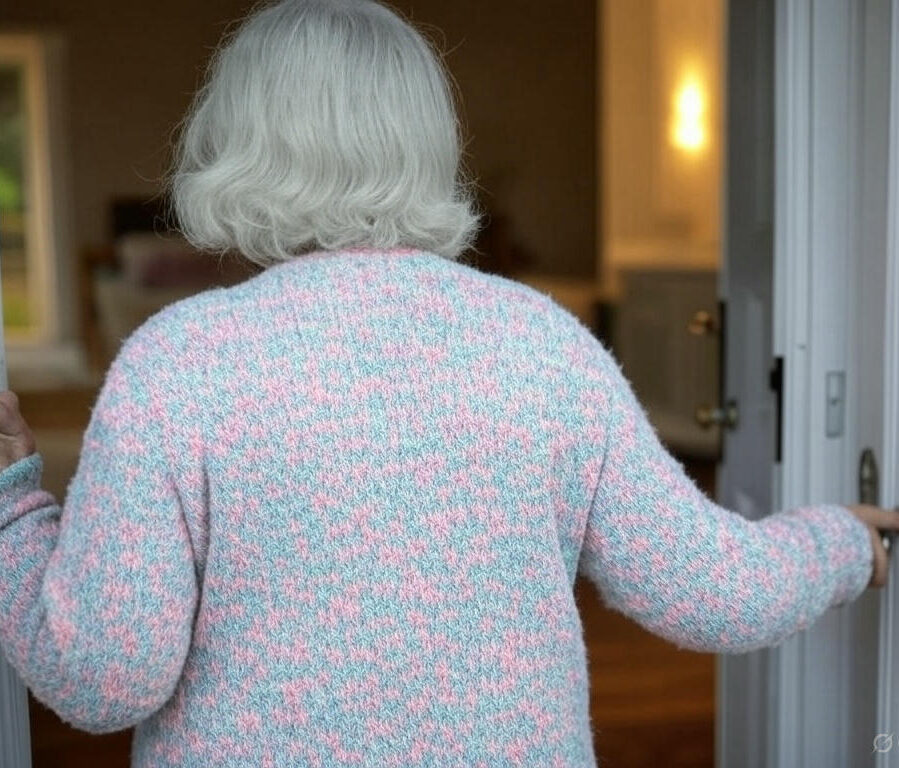Best Door Locks for Dementia Wandering: A Caregiver’s Guide to Safer Exits
Start Here: What Matters Most in Your Home?
Before choosing a lock, ask yourself:
- Do I need to control access remotely or get notified of exits?
- Does my loved one live alone or with others?
- Is quick exit access needed for emergencies?
- Do we have Wi-Fi or smart home devices?
- Would a fingerprint or keypad entry help if someone is locked out?
This guide will walk you through the different types of locks and help you choose what fits best, based on needs, not just features.
Types of Dementia-Friendly Door Locks
Each type of lock offers a different layer of support. Many caregivers find that layering locks with sensors or alerts works best over time.
1. Smart Locks (Wi-Fi or Bluetooth-Enabled)
Why Caregivers Choose Them
Smart locks go beyond basic safety. They offer real-time visibility, remote control, and peace of mind. You can lock or unlock doors from your phone, get alerts if someone exits, and track who’s coming and going whether you’re home or not.
Best for:
- Homes with Wi-Fi or smart speakers
- Caregivers who want visibility and control, even when off-site
- Overnight protection without restricting routines
Pros
- Lock/unlock from a phone, Alexa, or Apple Watch
- Get alerts when someone leaves or enters
- Add codes for emergency responders or visiting family
Considerations:
- Most smart locks require Wi-Fi or Bluetooth to function properly.
- Some models offer built-in video doorbells or cameras for extra visibility.
- Be sure the lock has a manual key backup in case of tech issues or low battery.
Tip: If you already use a smart speaker like Alexa, consider choosing a lock that integrates seamlessly. You can even set routines, such as “Lock the door at 9 PM,” for added peace of mind.
STFS Recommended Smart Locks for Dementia Safety:
Eufy Security Video Smart Lock E330 , Camera, and Doorbell
- Deadbolt lock
- Relatively easy Installation & WiFi Connection
- Multiple Methods for Entry:
- Fingerprint: Especially handy during the early stages of dementia if your loved one or caregivers find themselves locked out.
- Keycode: Offers simple entry and tracks who’s using it. A code can also be shared with emergency services.
- Physical Key: A backup option in case the battery runs out. A handy low battery warning is provided.
- Remove Unlock and Locking – Apps and Smart Devices such as Apple Watch, Alexa and Google Assistant.
- Notification when the door is locked and unlocked.
- Can set routines in Alexa to lock the door at a certain time each day
- Doorbell with Video Camera: Allows you to monitor who’s coming and going, adding an extra layer of safety for those at risk of wandering.
If you already have a video doorbell, this model provides the same support without the doorbell and camera.
Eufy Security Smart Lock C220, Fingerprint Keyless Entry Door Lock
2. Manual Locks: A Smart Companion for Layered Safety
Why Caregivers Choose Them
Manual locks may seem simple, but when used in conjunction with smart locks, they provide an additional layer of protection that doesn’t rely on Wi-Fi or apps.
Think of it like this:
- A smart lock helps you stay in control from anywhere.
- A manual lock adds friction, slowing or deterring someone from exiting unnoticed.
Together, they provide both visibility and physical safety.
Common Types of Manual Locks for Dementia Safety:
- Reinforcement Locks: Installed high on the door with a flip latch. Subtle but strong. Great with a smart lock that tracks entry.
- Top-Mounted Deadbolts: Traditional design, but installed out of sight and reach.
- Child Safety Locks: Budget-friendly for interior doors—adds quick layers without drilling or tech.
Best For:
- Overnight protection or unsupervised times
- Layering with smart tech: Manual locks can reduce the chance of someone slipping out in the time it takes for device notification and response.
- Homes with limited Wi-Fi or smart home access: Offers peace of mind without needing apps, batteries, or connections.
- Discreet deterrents: Higher or discreetly placed locks reduce visual cues for exit-seeking behaviors without appearing restrictive.
Pros
- No batteries or Wi-Fi needed
- Easy to install and use
- Reduces exit-seeking with fewer visual cues
- Often placed high or out of sight to deter access
Watch For:
Ensure your setup doesn’t block safe exit! Practice using your locks during an emergency. For example, you might want a reinforcement lock inside, but a smart lock or key access outside in case someone gets locked out.
Tip: Manual locks work best when placed higher on the door or used in a discreet location. For added safety, pair them with a door alarm or camera to get notified if an exit attempt happens, giving you more time to respond.
STS Recommended Reinforcement Locks for Dementia Safety:
Home Security Door Lock, Reinforcement Door Locks
Prime-Line Door Reinforcement Lock
3. Door Knob Lock-Out Devices
Why Caregivers Choose It
These affordable covers fit over standard round doorknobs and block the turning motion, making it hard for someone with dementia to open the door without help. They’re subtle, quick to install, and useful for both interior and exterior doors.
Best For:
- Nighttime safety or naps when supervision is lower
- Interior doors (like garages, basements, or laundry rooms)
- Travel setups or rentals
- Adding a temporary solution without permanent changes
Pros:
- Inexpensive and easy to install
- No tools or tech needed
- Strong visual and physical deterrent
- Ideal for short-term or supplemental use
Watch For:
These only work on round knobs, not levers. Some models may be tricky for caregivers with arthritis or hand weakness to remove quickly—practice is key.
Tip: Use these devices in combination with alarms or motion sensors for added awareness, especially on doors that might be accessed while you’re sleeping or distracted.
STS Recommended Door Knob Lock Out Devices for Dementia Safety:
Door Knob Lock-Out Device – Key Access
Door Knob Lock-Out Device – Combination Access
A less secure but easier access option for caregivers:
EUDEMON 4 Pack Baby Safety Door Knob Covers
4. Door Alarms
Why Caregivers Choose It
Door alarms notify you immediately if your loved one opens a door—especially helpful at night or when you’re in another room.
Best for:
- Overnight protection while caregivers are asleep
- Early awareness of exit attempts
- Layering with locks or cameras for extra safety
- Homes where caregivers can’t always be nearby
Pros:
- Sends alerts when doors are opened
- Affordable and renter-friendly
- No Wi-Fi required for basic models
- Simple installation
Things to Keep in Mind
- Loud alarms may startle your loved one
- Doesn’t physically stop wandering
- Requires regular battery checks
Tip: Depending on your situation, consider a model with a quiet mode or smartphone alerts. These features help you stay aware without disrupting routines or causing unnecessary anxiety.
STS Recommended Door Alarms for Dementia Safety:
WiFi Door Sensor: Smart Door Open/Closed Detectors
GE Personal Security Door Alarm
Choosing the right door lock is an important step—but it’s just one piece of the puzzle.
As dementia progresses, needs change. What works today may need to be adjusted tomorrow. That’s why it helps to think in layers: combine door locks with motion sensors, alarms, and location tools to build a system that fits your home and grows with you.
This layered approach gives you peace of mind, faster response times, and more options when it matters most.
You don’t have to do it all at once. Start with what fits best today—then build from there.
Explore the Dementia Wandering Safety Dashboard for tech tools, checklists, and support.





